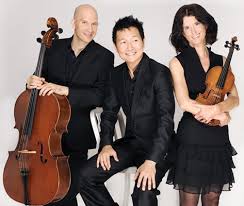Taste
Perfection in a Exquisite Setting
It’s rare to find a restaurant whose dishes are so seductively sublime,
it’s able to reach the highest calibre of flavour purity. But Bistro on the
Avenue has succeeded in doing this. By refusing to compromise on cuisine authenticity,
its modern creations attain palette-pleasing paradise without excess.
Simply put, you won’t want to eat anywhere else after you enter this den of
delicious dishes. Cuisine class cooked with gourmet goodness. That’s what
you’ll discover at Bistro on the Avenue.
Opening December 3rd last year – thanks to owner Encan Obana
– this remarkable restaurant quickly overtook 30 others – earning the rank of
second best in the upscale area of Westmount,
Quebec, where it is located.
Enjoy the glitter
As soon as you enter, you instantly feel special sitting amidst the
royal-like Parisian decor. A stunning crystal chandelier glitters overhead, and
on the walls - delicate crystal sconces are reflected in the floor to ceiling
mirrors. This is neo-classical beauty basking within soft grey walls. Yet there
isn’t a trace of pretension here.
A unique team of chefs produce pleasure on your plate
It all starts with the smiling waiters, who carry the spirit of Bistro’s
truly caring staff. Most important, the team of four chefs have something so
many restaurant chefs don’t: they are all team palette-players; they work
together to bring their bi-monthly rotational menu to the peak of taste
perfection.
Head chef, Bulgarian-born Nelly Nikola, a recent graduate of Montreal’s École de Métier, who has just returned from
exploring Costa Rica’s
cuisine in a 3-week stint working with the illustrious chef Randy Siles, is
constantly on the look-out for freshness in produce, originality and new ideas. “We consult together, so we learn
from one another. For example, Columbian talent, Johnny Miranda is a third
generation family chef with over 20 years experience cooking all over the
world. Our sommelier is from Afghanistan,
and of course our Montreal
chef inputs tremendously.”
Nelly stressed how much she values local produce. “Each dish we serve is
an example of the team’s philosophy. But
locally, choose the main dish and marry the herbs without overwhelming the
basic beauty of taste. Everyone has a different palette, so flexibility while
maintaining freshness and taste balance is so important. We never mix lots of
ingredients in one dish.”
Simplicity
Creates Stunning Surprises
My friend and I recently discovered the place while casually strolling
along Greene Avenue.
I loved the bistro’s elegant interior. Would the food match such beauty? I had the bacon, caramelized onion with
spinach omelette for breakfast, and to date, I have never tasted such a divine omelette.
It was thick, not watery or greasy. The melted Gouda cheese was generously applied, yet this
omelette was not bulky or overcooked. It was exceptional. My companion ordered
the strawberry, banana crepe swarming in warm chocolate, He is a crepe connoisseur,
so when he raved it was indeed the finest to ever enter his mouth, I was
impressed. We decided to return the following week to try some of the lunch
offerings.
Unsurpassable
Taste and Texture
We delved into several dishes from the menu. The result? Never in my life have I ever had such fine
tasting food. Bear in mind, I have been sent to France as a food critic, and I can
honestly say, what I tasted there can’t compare to the taste pleasure at Bistro.
Maybe, it’s because, here, they do not drown the dishes in sauces, and overcook
the main staple, hoping perhaps that somehow presentation will supplant
essential true-to-taste that Bistro on the Avenue has awesomely mastered.
I ordered the pasta with braised
beef; it was mixed with home-made wide Pappardelle pasta. Very nice indeed. I also ordered
the brisket whose sweetness enhanced the tenderly grilled generous portion of meat.
I totally loved the veal picatta. It was flavoured in lemon juice, with white
wine, capers, garlic and butter. This was a favourite for me, but it tied with
the amazingly brilliant grilled chicken. So tender, so delectable, so perfectly
flavoured and delicately balanced in lemon juice. On to another goodie: the
shrimp burger. It was a pretty-looking paddy sporting a touch of coriander. Again, another taste bud winner!

I’m a frank food critic, so when I tried to find something wrong with a
dish, I couldn’t. Something more to gush over was the service: on both
occasions, it was superbly appealing, extremely patient and attentive.
Oh, Sweet Excellence… to sip
and savour
Wines galore and so much more… at your table or at the bar. Bistro on
the Avenue has a cute, unobtrusive bar at the entrance. It boasts an amazing
collection of alcohol (over 36 kinds of vodka to mention just some of the
varieties to imbibe) and a wine selection of over 50 international kinds. I had
the 2015 Bourgogne Aligoté – a smooth white that harmonized with my shrimp burger;
my companion ordered the interesting 2014 red Italian cuvée Ripasso. We ended
the meal, sharing a banana crème brûlé, undercoated in delectable melted
chocolate. It was deliciously sinful, but I was in heaven!
Every Monday, Bistro on the Avenue features Ladies’ Night with an
awesome assortment of martinis. Tuesday nights are all-you-can-eat tartare, and
Wednesday is all-you-can eat mussels.
Bistro
on the Avenue’s address is:
1362 Greene Ave, Westmount,
QC H3Z 2A5
Email them at: info@bistroontheavenue.com
The website is: bistroontheavenue.com




































